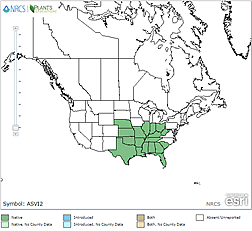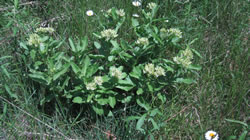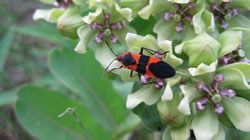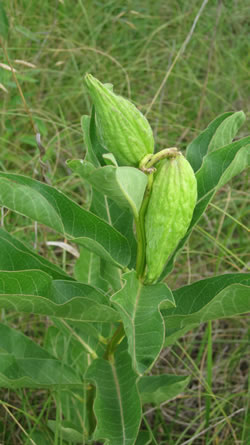Plant of the Week
 Asclepias viridis range map. USDA PLANTS Database.
Asclepias viridis range map. USDA PLANTS Database.
 Whole plant with flowers. Photo © David D. Taylor.
Whole plant with flowers. Photo © David D. Taylor.
 Colony of plants. Photo © David D. Taylor.
Colony of plants. Photo © David D. Taylor.
Green Antelopehorn (Asclepias viridis)
By David Taylor
Green antelopehorn is a member of the Asclepiadaceae (milkweed) family. It is one of about 115 species that occur in the Americas. Most species are tropical or arid land species. The genus name, Asclepias, commemorates Asklepios, the Greek god of medicine. Some of the milkweed species have a history of medicinal use including common milkweed, (wart removal and lung diseases) and butterfly weed, A. tuberosa (aka pleurisy root—pleurisy and other lung disease). The specific epithet, viridis, means ‘green’ in reference to the color of the flower.
This milkweed grows to about 0.6 meters (2 feet) tall, occurring as single stems or in clusters a few to many stems. It has a deep rootstock which helps it survive drought. Leaves are 6 to 15 centimeters (2.5 to 6 in) long and 3 to 13 centimeters (1.25 to 7 in) wide. They are somewhat thin and alternate to almost opposite on the thick stem. The upper surface is green to dark green while the lower surface is lighter. Broken leaves and stems exude a milky latex. Flowers are borne in a flattened to spherical cluster at the top of the plant. Each flower is 2 to 3 centimeters (0.75 to 1.25 in) across and 10 to 12 millimeters (3/8 in) long. Flowers are light green with a purplish center. Fruits (pods) are, thin, without surface projections, somewhat wrinkled, and highly inflated (upwards of 7 centimeters or 2.5 inches diameter). They are light green turning straw colored as they mature. They split open revealing 50-100 seeds each with a white, fluffy coma ("parachute") that allows wind dispersal.
Green antelopehorn, also known as green milkweed, is heavily attacked by the large (Oncopeltus fasciatus) and the small (Lygaeus kalmia) red and black milkweed bugs. They are particularly destructive as both the adults and nymphs are seed predators. They can destroy 80 to 90% of a colony's seed crop. This species is one of the first milkweeds to bloom in the Ohio Valley (May to June) and provides food for the first milkweed bugs to emerge. In the Ohio Valley, monarchs and milkweed tussock moths are seldom found on this species as it sheds its leaves and goes dormant in late June to early July before these species arrive in the area.
It is a species known from Nebraska to Texas east to Ohio and West Virginia, Kentucky, Tennessee and south from South Carolina to Florida. It is frequently found in fields, and in prairies and pastures. Given the opportunity, it will establish in gardens and even thin lawns. It is tolerant of light shade, but generally is a full sun species.



